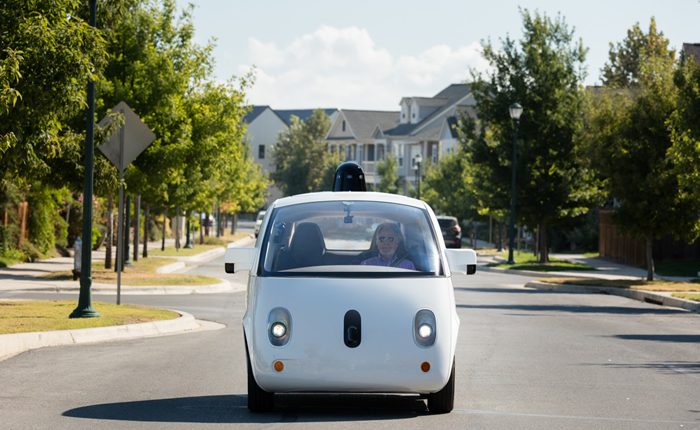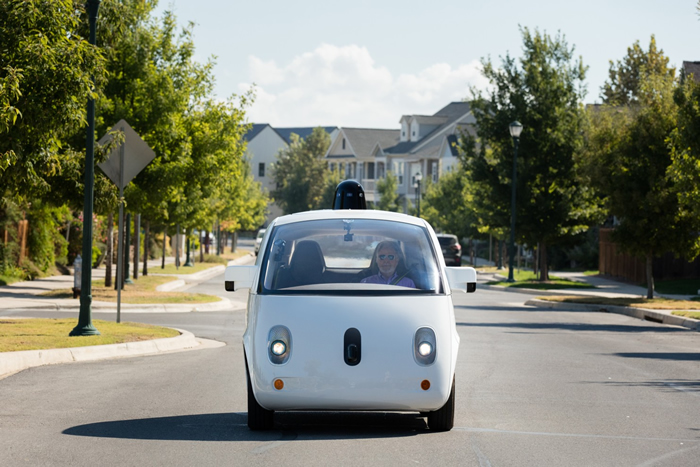Google’s driverless car transports blind man
A blind man has successfully traveled around Austin — unaccompanied — in a car without a steering wheel or floor pedals, Google has announced.
After years of testing by Google engineers and employees, the company’s new level of confidence in its fully autonomous technology was described as a milestone.
“We’ve had almost driverless technology for a decade,” said Google engineer Nathaniel Fairfield. “It’s the hard parts of driving that really take the time and the effort to do right.”
Steve Mahan, who is legally blind, was the first non-Google employee to ride alone in the company’s gumdrop-shaped autonomous car.
“It is like driving with a very good driver,” Mahan said. “If you close your eyes when you’re riding with somebody, you get a sense of whether this is a good driver or whether they’re not. These self-driving cars drive like a very good driver.”
Google says it has driven more than 2 million miles on public roads to test its vehicles.
“In early 2015, we began to see some signs that we were getting close,” Fairfield said. “The cars were going for longer and longer times without the humans having to intervene.”
Fairfield said the company spent six months scrutinizing the vehicle’s performance before Mahan was allowed to set out alone.
“That is a whole different beast — to get that driver out of the car, to take off the training wheels,” Fairfield said.
Mahan said: “I had the greatest time driving around a neighborhood in Austin, Texas. It was so much fun, being aware that the vehicle was navigating intersections and I was in good hands, perfectly safe.”
The car Mahan rode in had a backup computer and multiple systems to control it.
“If you removed the driver from the loop, you really have to have your backups,” said Dmitri Dolgov, who heads technological development for Google’s self-driving effort.
Mahan said: “This is a hope of independence. These cars will change the life prospects of people such as myself. I want very much to become a member of the driving public again.”
Google also announced Tuesday that it is spinning off its self-driving-car project into a company called Waymo, an independent division under Google’s parent company, Alphabet.
John Krafcik, chief executive of Waymo, said the Austin solo ride is an indication that “we’re close to bringing this to a lot of people.”
Costa Samaras, an automation expert at Carnegie Mellon University, said the move by Waymo “puts a marker down that says to Uber, Lyft and auto companies that the race to capture market share in driverless mobility has begun in earnest.”
Samaras said that “without a human in the loop, there’s also now a lot less room for computer error in case something goes wrong. I’m guessing Waymo has run these numbers and is betting on the computer.”
Google was among the first technology companies to plunge into an area traditionally dominated by automakers in Detroit and elsewhere in the world. After initial testing by its employees, the company embraced a decision to put fully autonomous cars on the road — probably without steering wheels or floor pedals — from the outset. In that decision, Google became an outlier, as the existing industry, mindful of its need to sell cars each year, took an approach intended to introduce self-driving features incrementally.
The Google announcement came on a day when the Obama administration proposed a rule that would require all new cars to be able to communicate with other cars wirelessly, a move that advocates said could save lives but that also raises privacy and hacking concerns among opponents.
The wireless box could, for instance, tell a car to brake when another vehicle is about to run a red light. Federal officials said the required technology “will not collect, broadcast or share information linked or linkable, as a practical matter, to individuals or their vehicles.”
Vehicle-to-vehicle communication is considered an essential building block toward autonomous vehicles by some — but not all — of the companies working to develop them.
“If they’re connected to each other, then we likely will not need signs, markings or even traffic signals,” said Jim Barbaresso, vice president for intelligent transportation systems at HNTB Infrastructure Solutions. “Cars could go through intersections without hitting each other, without the need of a traffic signal.”
Fairfield said direct vehicle-to-vehicle communication is an asset but less than essential to putting autonomous cars on the road.
“There is vehicle technology where the car is telling you it’s going to hit the brakes or how much it’s braking,” Fairfield said. “That’s somewhat useful, but we can [determine] that with radars and lasers and cameras, so it’s not that useful.”
The Competitive Enterprise Institute, a Washington-based conservative think tank, called the administration’s rulemaking bid a “midnight” move. Marc Scribner, a research fellow, said the incoming Trump administration should immediately withdraw the “dangerous” proposal.
More information: The Washington Post



Comments are closed, but trackbacks and pingbacks are open.